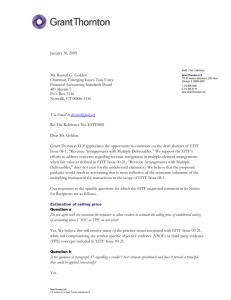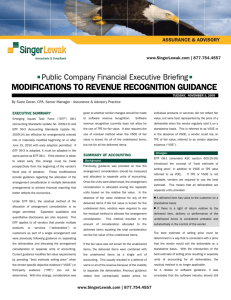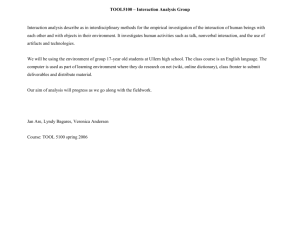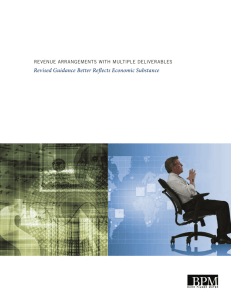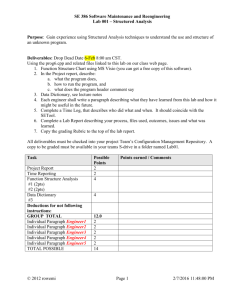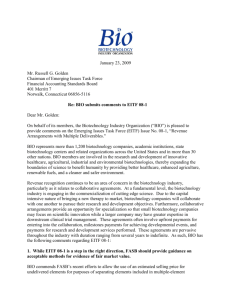4. Multiple Deliverable Revenue Arrangements, 2009
advertisement
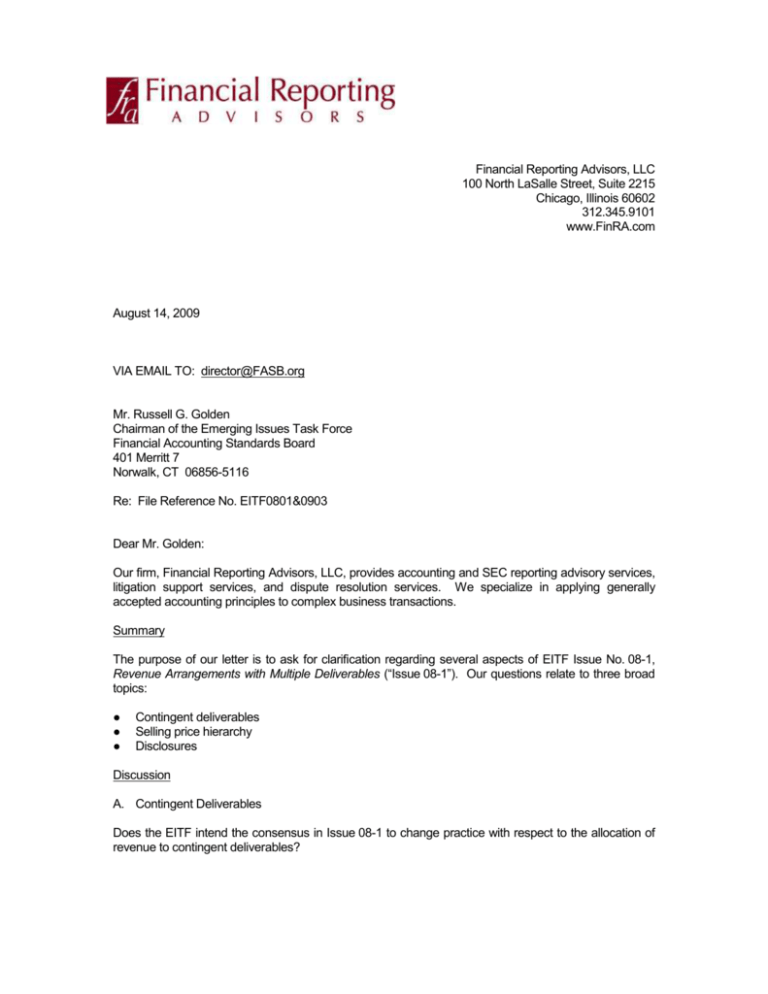
Financial Reporting Advisors, LLC 100 North LaSalle Street, Suite 2215 Chicago, Illinois 60602 312.345.9101 www.FinRA.com August 14, 2009 VIA EMAIL TO: director@FASB.org Mr. Russell G. Golden Chairman of the Emerging Issues Task Force Financial Accounting Standards Board 401 Merritt 7 Norwalk, CT 06856-5116 Re: File Reference No. EITF0801&0903 Dear Mr. Golden: Our firm, Financial Reporting Advisors, LLC, provides accounting and SEC reporting advisory services, litigation support services, and dispute resolution services. We specialize in applying generally accepted accounting principles to complex business transactions. Summary The purpose of our letter is to ask for clarification regarding several aspects of EITF Issue No. 08-1, Revenue Arrangements with Multiple Deliverables (“Issue 08-1”). Our questions relate to three broad topics: ● ● ● Contingent deliverables Selling price hierarchy Disclosures Discussion A. Contingent Deliverables Does the EITF intend the consensus in Issue 08-1 to change practice with respect to the allocation of revenue to contingent deliverables? Mr. Russell G. Golden August 14, 2009 Page 2 File Reference No. EITF0801&0903 We would have expected the answer to that question to be “no” given the EITF’s explicit decision not to address whether or how contingent deliverables should affect revenue recognition.1 However, there is some question as to whether the exclusion of contract manufacturing from the Biotech example should be viewed as evidence that the treatment of contingent deliverables should differ from the example provided in EITF Issue No. 00-21, Revenue Arrangements with Multiple Deliverables, (“Issue 00-21”). Example 6 in Issue 00-21 addresses a multiple element arrangement in which Biotech undertakes to provide Pharma with (i) a license to a drug that is being developed, (ii) R&D activities to further the development of the drug, and (iii) contract manufacturing to produce the drug if it is successfully developed. Issue 00-21 concludes that the arrangement includes three deliverables—license, R&D services, and contract manufacturing. In contrast, the Biotech example in the draft abstract of Issue 08-1 makes no mention of contract manufacturing in the assumed facts.2 Example 12 in the draft consensus of Issue 08-1 addresses a fact pattern in which Biotech agrees to provide (i) licensing rights (including the right for Pharma to manufacture the drug) and (ii) R&D services. No other deliverables are specified or implied. At its August 2008 meeting, the Working Group for Issue 08-1 discussed an example entitled “R&D Arrangement -- Contingent Deliverable.” Those assumed facts involved an arrangement calling for R&D services on a best efforts basis and contract manufacturing services that would be provided if the 1 Extract from September 10, 2008 EITF Minutes on Issue 08-1: 8. The issues are: Issue 1—Whether "access or standing ready to perform" can be a deliverable Issue 2—Whether and how contingent deliverables should impact revenue recognition Issue 3—How the proportional performance model should be applied to a single unit of accounting composed of multiple deliverables Issue 4—Whether recognition of revenue on a straight-line basis is acceptable when the goods or services may not be delivered ratably over the period Issue 5—Whether to modify the objective-and-reliable-evidence-of-fair-value threshold of Issue 00-21 Issue 6—Whether to issue guidance on the application of the milestone method of revenue recognition. 9. The Task Force discussed Issues 1 through 4 and tentatively agreed not to provide guidance on them. Some members of the Task Force noted that in order to address those issues the Task Force may need to create a definition of a deliverable, which they believed would take longer than one year. The definition of a deliverable is currently being addressed in the Board's revenue recognition project. Task Force members also noted that a change to the objective-and-reliable-evidence-of-fair-value threshold in Issue 00-21 might reduce or resolve some of those issues without requiring additional standards setting. Therefore, the Task Force tentatively agreed not to provide guidance on Issues 1 through 4. Example 12 is titled “Biotech License, Research and Development, and Contract Manufacturing Agreement.” We assume the reference to a contract manufacturing agreement in the title is a typographical error. The facts state that the license “gives Pharma the exclusive right to … manufacture Drug B” and that “there are no when-and if-available clauses or other performance obligations associated with the license” except for the research and development activities. Accordingly, contract manufacturing is not a part of the arrangement. 2 Mr. Russell G. Golden August 14, 2009 Page 3 File Reference No. EITF0801&0903 R&D resulted in a commercially viable product.3 The minutes of the meeting indicate that the Working Group members held “mixed views” as to whether Issue 00-21 “currently requires Contingent Deliverables to be considered deliverables at the inception of an arrangement.” Issue Summary No. 2 dated October 20, 2008 references the Working Group discussion and states that the FASB staff removed Example 6 from its proposed redrafting of Issue 00-21 on the basis that the EITF had decided not to address contingent deliverables as part of Issue 08-1. Our experience is that practice is consistent with Example 6 in Issue 00-21: contingent deliverables such as the contract manufacturing services in the Biotech arrangement are considered to be deliverables at the inception of the arrangement. However, the change in the Biotech example raises a question as to whether that practice should continue. We are uncertain as to the EITF’s intent. We support the EITF’s conclusion that contingent deliverables—what they are and whether they should affect revenue recognition—should not be addressed in Issue 08-1. We recommend that the fact pattern for Example 12 in the draft consensus of Issue 08-1 be modified to be consistent with the fact pattern in Example 6 of Issue 00-21. By making this modification, the EITF would continue the status quo with respect to contingent deliverables and avoid creating confusion from what might be inferred from the proposed change to this example. We support Issue 08-1 being finalized without delay and believe this modification to Example 12 should not slow down the issuance of the final consensus. If EITF members believe there is significant diversity in practice with respect to allocation of revenues to contingent deliverables in multiple element revenue arrangements, we believe that issue should be the subject of a separate, standalone EITF issue. If the EITF does not make this modification to Example 12, we strongly recommend that the final consensus be explicit about what change in practice, if any, is intended with respect to contingent deliverables in multiple element revenue arrangements. B. Selling Price Hierarchy Does the EITF intend the phrase “vendor specific objective evidence” (VSOE) to be implemented in a manner consistent with longstanding practice in the software industry? We would have expected the answer to be "no" for several reasons, not the least of which is that the inability to determine VSOE of the selling price of an undelivered element does not preclude revenue recognition for delivered elements under Issue 08-1. The software literature uses the term “VSOE” as a means of limiting the circumstances in which revenue can be allocated amongst multiple elements. However, it would not surprise us if practice will conclude that it is appropriate to implement the term “VSOE” consistently. Aspects of Issue 08-1 seem to imply a consistent application of the term. For example, the language in paragraph 16 of Issue 08-1 addressing deliverables not yet sold separately is substantially identical to the language in the software literature. If “VSOE” is not to be implemented consistently, why would Issue 08-1 address VSOE of selling price for items not yet sold separately? If the items are not sold separately, wouldn’t third party evidence or management’s best estimate be used to establish selling price? Further, the disclosure example provided in Issue 08-1 explains the 3 See extract from Working Group Report No. 2 attached as Appendix A to this letter. Mr. Russell G. Golden August 14, 2009 Page 4 File Reference No. EITF0801&0903 determination of VSOE of selling price in a manner that is wholly consistent with the rigorous, dataintensive bell-shaped curve approach used in the software industry. We agree that the vendor’s actual selling price for a deliverable that is regularly sold on a standalone basis should take precedence over third party selling prices for largely interchangeable products or services. We agree that estimates of selling prices should be used only in the absence of these more objectively determinable amounts. However, given that the relative selling price method gives equal weight to all three sources of selling price information, there would seem to be no reason to insist on the level of rigor that is clearly appropriate in software transactions. Issue 08-1 will use VSOE only as one way to decide how to allocate revenue, but its absence would never preclude allocation, as it does under SOP 97-2. As such, we believe that less discipline and rigor is needed in evaluating whether VSOE exists under Issue 08-1. If the EITF does not believe that VSOE should be implemented for non-software transactions consistent with longstanding practice in software transactions, we suggest that the final consensus use different terminology to refer to vendor specific selling prices. C. Disclosures We have several questions related to the proposed disclosure requirements in Issue 08-1 (and incorporated into Issue 09-3). 1. How do the disclosure objectives in paragraph 20 reconcile with the specific disclosure requirements in paragraph 21? Paragraph 20 of Issue 08-1 defines the stated objective of the disclosures as being “information regarding the significant judgments made in applying this Issue and changes in either those judgments or the application of this Issue that may significantly affect the timing or amount of revenue recognition.” (emphasis added) However, certain of the disclosures listed in paragraph 21 require information that is unrelated to significant judgments, changes in judgments or changes in the application of the requirements of Issue 08-1. For example: ● The disclosures regarding the nature of the arrangements; significant deliverables; general timing of delivery or performance; provisions related to performance, cancellation, termination and refunds; and the general timing of revenue recognition (paragraph 21 a, b, c, d, and g) seem to be general revenue recognition disclosures rather than disclosures that are unique to multiple element arrangements. Further, all of these disclosures involve factual information rather than information related to significant judgments. It is therefore unclear as to whether these disclosures are intended to apply to all revenue arrangements; all multiple element arrangements (including multiple element arrangements covered by other literature such as software revenue recognition or construction contracts); or only multiple element arrangements not covered by other literature. ● In many multiple-element arrangements, the elements are either delivered concurrently or within the same accounting period. Given that such transactions do not involve judgment about the period in which revenue is recognized, the disclosure objective in paragraph 20 would suggest that the requirements of paragraph 21 do not apply. Yet the disclosure example related to agricultural equipment (Example 11) implies that the requirements apply to Mr. Russell G. Golden August 14, 2009 Page 5 File Reference No. EITF0801&0903 multiple element arrangements in which all elements have been delivered. If this is the EITF’s intent, it would be helpful to be more clear as to the scope of these disclosures. ● Vendor-specific selling prices and third party selling prices would, by definition, appear to require little in the way of judgment. Estimated selling prices, by definition, require the use of judgment. However, the disclosures related to the effects of changes in selling prices do not appear to be limited to changes in estimated selling price. Paragraph 21h refers to “changes in … the selling price” rather than “changes in the estimated selling price.” Further, the disclosure example in Example 11 provides no indication as to whether the increase in selling price used in the allocation of consideration results from a change in a significant judgment or a change in facts (e.g., a change in VSOE). When the detail disclosure requirements are not aligned with the disclosure objective, it is inevitable that practice will be unable to determine how to comply with the disclosure objective. How, for example, could one appropriately determine what “other qualitative and quantitative information” is “necessary to comply with this objective” (as required by the last sentence of paragraph 20) when the identified disclosures are not clearly aligned with the objective? Equally as inevitable are questions about the applicability of these disclosures to transactions that are not within the scope of Issue 08-1. For example, if performance, cancellation, termination and refund type provisions are a necessary disclosure for non-software multiple element transactions, are they also required for software transactions involving multiple elements? For single element revenue transactions? If the EITF concludes that the information in paragraph 21 a, b, d and g should be disclosed, we suggest that these disclosures be identified as incremental to the information required to meet the objective in paragraph 20. We also suggest that the EITF indicate the applicable scope of such disclosures. 2. Does the EITF intend the disclosure requirements related to significant changes in judgment and changes in the application of Issue 08-1 (i.e., the requirements of paragraph 21h) to differ from the requirements for changes in accounting estimates and changes in the application of accounting principles as set forth in ASC Topic 250-10 (FASB Statement No. 154, Accounting Changes and Error Corrections)? We strongly support disclosure of changes in estimate when the effects are significant. However, we would have expected the existing literature to be sufficient to meet that disclosure objective. For example, existing literature states that disclosure of the effects of changes in estimate is not necessary for estimates made each period in the ordinary course unless the change is material. It also states that when a change in estimate does not materially affect the period of change but is reasonably certain to have a material effect in later periods, disclosure in the period of the change in estimate is required. As drafted, we expect that practice will be uncertain as to whether paragraph 21h is intended to illustrate the application of ASC Topic 250-10 to these arrangements or if it is intended to provide for disclosures that are incremental to other literature. 3. Do the disclosures required by paragraph 21 apply to software transactions? For example, do the disclosures in paragraph 21e apply to the significant factors, inputs, assumptions and methods used to determine VSOE of selling prices? While we are uncertain as to the value of this detailed Mr. Russell G. Golden August 14, 2009 Page 6 File Reference No. EITF0801&0903 information to users of financial statements, if the concept of VSOE for nonsoftware and software transactions is substantially the same, should the same disclosures apply? 4. While we are not preparers of financial statements, we wonder how the disclosures in paragraphs 20-21 can be operational given the example of the application of those requirements to the facts in Example 11. In that example, a fact pattern involving only one type of multiple element arrangement involving no performance, cancellation, termination or refund provisions and only one change in selling price for one unit of accounting results in 15 paragraphs of narrative that is incremental to the existing revenue recognition policy disclosures. 5. What disclosures are required by paragraph 21h? As drafted, the paragraph explains the circumstances that trigger disclosure but not the information to be disclosed. The example disclosure (Example 11) is not helpful in this regard. Further, in the example disclosure, we are curious about the reference to the effect of price increases on future overall revenues from multiple element arrangements. Could that statement be perceived as a forecast? 6. Paragraph 21h refers to the effect on the allocation of arrangement consideration resulting from changes in the selling price (or method of determining selling price) for a specific unit of accounting. Does the EITF intend for the determination of significance to ignore offsetting changes within a multiple element arrangement? Further, if the effect on the allocation of arrangement consideration is significant but the elements are delivered concurrently or in the same accounting period, is disclosure required? ----------- We appreciate the opportunity to comment on the draft consensus for exposure of Issue 08-1. If there are any questions, please contact Amy A. Ripepi at 312-345-9103. Sincerely, Very truly yours, Financial Reporting Advisors, LLC Appendix A Extract EITF Issue 08-1 Working Group Report No. 2 Prepared August 10, 2008 Practice Issues – Contingent Deliverables 27. The Working Group discussed whether and how contingent deliverables should impact an entity's revenue recognition attribution model. That is, whether a contingent deliverable should be evaluated at the inception of the arrangement as a deliverable, evaluated at the time of delivery as a deliverable (requiring re-evaluation of the arrangement under 00-21), or treated as a separate arrangement. 28. At the July 15, 2008 Working Group meeting, the majority of the discussion on contingent deliverables centered on defining a contingent deliverable and various scenarios involving contingencies in a revenue arrangement. Working Group members sorted those scenarios into the following three categories: a. Contingent Payments—The terms of the arrangement provide the vendor with additional consideration based upon the outcome of possible future events b. Optional Purchases—The terms of the arrangement provide the customer with an option to purchase products or services in the future c. Contingent Deliverables—The terms of the arrangement call for a revenue generating activity whose delivery is contingent upon the occurrence of a future event that is not exclusively within the control of the customer. If that future event occurs, the explicit terms of the arrangement require the vendor to deliver specified products or services. 29. The Working Group agreed that the treatment of Contingent Payments depends on whether the arrangement consideration is fixed or determinable. The Working Group also agreed to limit its consideration of whether an arrangement fee is fixed or determinable to those issues addressed under the heading "Practice Issues – Milestone Method." As it relates to Optional Purchases, there was general agreement among Working Group members that the issue of Optional Purchases is not causing practice concerns. 30. At the August 7, 2008 Working Group meeting, the Working Group continued its discussion of Contingent Deliverables. More specifically, the Working Group discussed whether Issue 00-21 currently requires Contingent Deliverables to be considered deliverables at the inception of an arrangement. Views on that question were mixed. However, Working Group members generally agreed that the proposed change to the fair value threshold of Issue 00-21 would solve the majority of the practice issues in this area. See Example 1, R&D Arrangement – Contingent Deliverable, included at Exhibit 08-1A, for an illustration of fact patterns frequently discussed in the context of this practice issue. 31. The Working Group decided to recommend that the Task Force not provide guidance on Optional Purchases or Contingent Deliverables. However, the Working Group also indicated that this recommendation should be reconsidered if the Task Force chooses not to accept the Working Group's recommendation related to the fair value threshold of Issue 00-21. .... Appendix A Example 1: R&D Arrangement – Contingent Deliverable 1. Biotech enters into an arrangement to provide research and development activities, on a best efforts basis, for a period of three years. In addition, if a commercially viable product is successfully developed as a result of those research and development activities, Biotech agrees to manufacture the resulting product for a period of five years. 2. Compensation under the arrangement is as follows: a. Biotech receives $250,000 per year for each full time equivalent (FTE) that performs research and development activities. b. Biotech receives "cost plus 30 percent" for manufacturing the resulting product (that is, Biotech will receive compensation for its direct costs plus a 30 percent margin for manufacturing the resulting product). -2-
